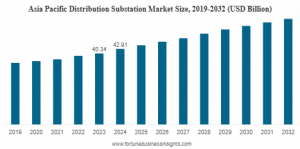The Global Distribution Substation Market Projected to Grow to USD 129.15 Billion with a CAGR of 3.77% during 2032
List of Top key Players in Distribution Substation industry are Hyundai Heavy Industries, ABB, Eaton, Siemens Energy, Mitsubishi Electric, Rockwell Automation
Asia Pacific dominated the global market with a share of 45.22% in 2024.”
PUNE, MAHARASHTRA, INDIA, October 1, 2025 /EINPresswire.com/ -- The distribution substation market is witnessing steady growth as global economies focus on strengthening power infrastructure and ensuring reliable electricity supply. Substations act as critical nodes in the power transmission and distribution network, stepping down high-voltage electricity from transmission lines to lower voltage levels suitable for end-user consumption. With increasing industrialization, urbanization, and the growing penetration of renewable energy sources, the demand for modern distribution substations is expected to rise significantly over the forecast period.— Fortune Business Insights
Request a Sample Research PDF: https://www.fortunebusinessinsights.com/enquiry/request-sample-pdf/distribution-substation-market-113479
Market Size and Growth Drivers
The global distribution substation market size was valued at USD 94.89 billion in 2024. The market is projected to grow from USD 99.64 billion in 2025 to USD 129.15 billion by 2032, exhibiting a CAGR of 3.77% during the forecast period. Asia Pacific dominated the global market with a share of 45.22% in 2024.
The market outlook for distribution substations reflects strong investment in grid expansion and modernization programs. Governments and private utilities are allocating substantial funds to upgrade aging infrastructure and integrate advanced technologies for greater efficiency. Key growth drivers include:
1. Urbanization and Infrastructure Expansion – The rapid rise in smart cities, residential complexes, and industrial hubs has amplified electricity consumption, creating demand for advanced substations that can handle fluctuating load requirements.
2. Integration of Renewable Energy – The increasing share of renewable energy sources like solar and wind requires substations capable of managing variable generation and ensuring stability in power supply.
3. Electrification of Transport and Industry – Growth in electric vehicle charging infrastructure and energy-intensive manufacturing processes is boosting investments in reliable distribution networks.
4. Digitalization of Grid Systems – Smart grid solutions, automation, and digital monitoring systems are transforming traditional substations into intelligent nodes capable of predictive maintenance and optimized energy flow.
Key Market Segments
The distribution substation market can be segmented based on:
Voltage Type: Low voltage, medium voltage, and high voltage substations, depending on application requirements.
Technology: Air insulated substations (AIS) and gas insulated substations (GIS).
Application: Residential, commercial, and industrial sectors, along with utilities that focus on public distribution.
Components: Transformers, circuit breakers, protective relays, busbars, switchgear, and monitoring systems.
Each segment is evolving with technological upgrades to improve efficiency, safety, and cost-effectiveness. GIS substations, for example, are becoming particularly relevant in metropolitan cities where land availability is limited.
Regional Insights
The market is expanding globally, with demand rising in both developed and emerging regions.
North America: Aging grid infrastructure and the push for renewable energy integration are driving investments in digital substations.
Europe: Energy transition policies, electrification initiatives, and smart grid development are key factors boosting demand.
Asia Pacific: Rapid industrial growth, rising urbanization, and government-led electrification projects in countries like China and India are making the region a dominant player.
Middle East & Africa: Investments in power generation and distribution to meet rising demand in urban centers are supporting market growth.
Latin America: Expansion of industrial zones and renewable energy projects are creating opportunities for substation modernization.
Competitive Landscape
The competitive environment is shaped by established global companies and regional players focusing on innovation, technology integration, and strategic collaborations. Leading firms are investing in R&D to develop compact, efficient, and digitally enabled substations. Partnerships with governments and utilities remain a common strategy to expand market presence.
Key focus areas for competition include:
Deployment of smart substations with AI-driven monitoring.
Development of eco-friendly switchgear technologies that minimize greenhouse gas emissions.
Expansion into high-growth emerging markets through joint ventures and local manufacturing.
Challenges in the Market
Despite strong growth prospects, the distribution substation market faces several challenges:
High Capital Costs – Establishing or upgrading substations requires substantial investment, which can strain budgets for utilities in developing economies.
Land Acquisition Issues – Urban expansion and limited space availability often hinder new substation installations.
Cybersecurity Concerns – As substations become increasingly digital, they face risks from cyberattacks and require robust security solutions.
Supply Chain Constraints – Shortages in raw materials and electronic components may delay projects and increase costs.
Future Outlook and Emerging Trends
The future of the distribution substation market is likely to be shaped by innovations that enhance efficiency, resilience, and sustainability. Emerging trends include:
Digital Substations – Growing adoption of digital technologies will enable utilities to remotely monitor performance, predict failures, and reduce downtime.
Eco-Friendly Solutions – Manufacturers are increasingly developing switchgear and substation equipment with reduced environmental impact, moving away from SF6-based technologies.
Hybrid Substations – Combining AIS and GIS technologies offers flexibility for both urban and rural deployment.
Resilient Infrastructure – With climate change and natural disasters becoming more frequent, substations are being designed with improved resilience to extreme weather.
Integration with Energy Storage – As renewable energy adoption grows, substations will increasingly integrate with battery energy storage systems to stabilize grid fluctuations.
Request a Sample Research PDF: https://www.fortunebusinessinsights.com/enquiry/request-sample-pdf/distribution-substation-market-113479
LIST OF KEY COMPANIES PROFILED IN THE REPORT:
Major players in the biochar market are focusing on strategic collaborations, mergers, and technological innovations to strengthen their market position.
Some key players include:
Hyundai Heavy Industries (South Korea)
ABB (Switzerland)
Eaton (Ireland)
Siemens Energy (Germany)
Mitsubishi Electric (Japan)
Rockwell Automation (U.S.)
Schneider Electric (France)
Toshiba Energy Systems Solutions Corporation (Japan)
General Electric (U.S.)
Larsen Toubro (India)
Ashwin Arora
Fortune Business Insights™ Pvt. Ltd.
+1 833-909-2966
sales@fortunebusinessinsights.com
Legal Disclaimer:
EIN Presswire provides this news content "as is" without warranty of any kind. We do not accept any responsibility or liability for the accuracy, content, images, videos, licenses, completeness, legality, or reliability of the information contained in this article. If you have any complaints or copyright issues related to this article, kindly contact the author above.

